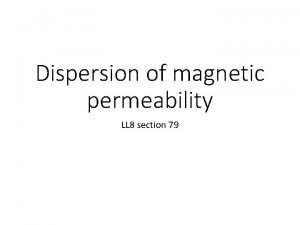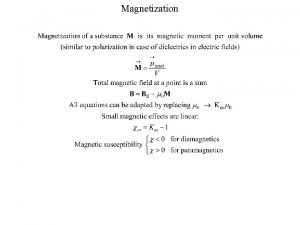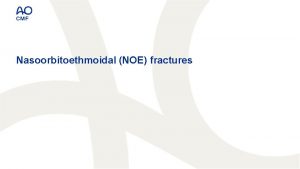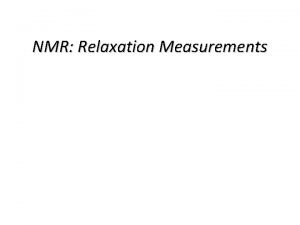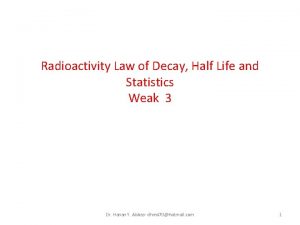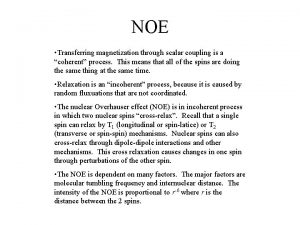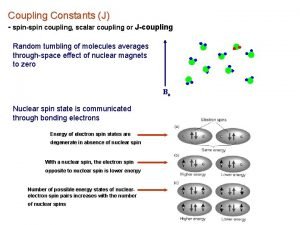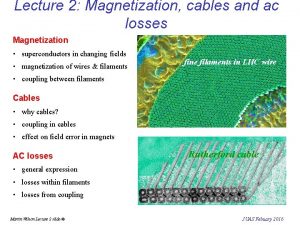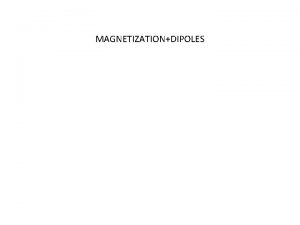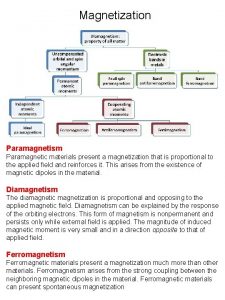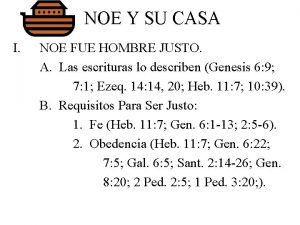NOE Transferring magnetization through scalar coupling is a















- Slides: 15

NOE • Transferring magnetization through scalar coupling is a “coherent” process. This means that all of the spins are doing the same thing at the same time. • Relaxation is an “incoherent” process, because it is caused by random fluxuations that are not coordinated. • The nuclear Overhauser effect (NOE) is in incoherent process in which two nuclear spins “cross-relax”. Recall that a single spin can relax by T 1 (longitudinal or spin-latice) or T 2 (transverse or spin-spin) mechanisms. Nuclear spins can also cross-relax through dipole-dipole interactions and other mechanisms. This cross relaxation causes changes in one spin through perturbations of the other spin. • The NOE is dependent on many factors. The major factors are molecular tumbling frequency and internuclear distance. The intensity of the NOE is proportional to r-6 where r is the distance between the 2 spins.

Qualitative Description 2 spins I and S bb n 4(*) WI(2) (***) n 2 ab W 2 WS(2) ba W 0 WI(1) WS(1) aa n 1(***) Two nuclear spins within about 5 Å will interact with each other through space. This interaction is called cross-relaxation, and it gives rise to the nuclear Overhauser effect (NOE). Two spins have 4 energy levels, and the n 3(*) transitions along the edges correspond to transitions of one or the other spin alone. W 2 and W 0 are the cross-relaxation pathways, which depend on the tumbling of the molecule.

dn 1/dt = -WS(1)n 1 -WI(1)n 1–W 2 n 1 + WS(1)n 2+WI(1)n 3+W 2 n 4 … etc for n 2, 3, 4 using: Iz= n 1 -n 3+n 2 -n 4 Sz= n 1 -n 2+n 3 -n 4 2 Iz. Sz= n 1 -n 3 -n 2+n 4 One gets the ‘master equation’ or Solomon equation d. Iz/dt = -(WI(1)+WI(2)+W 2+W 0)Iz – (W 2 -W 0)Sz –(WI(1)-WI(2))2 Iz. Sz d. Sz/dt = -(WS(1)+WS(2)+W 2+W 0)Sz – (W 2 -W 0)Iz – (WS(1)-WS(2))2 Iz. Sz d 2 Iz. Sz/dt = -(WI(1)+WI(2)+ WS(1)+WS(2))2 Iz. Sz - (WS(1)-WS(2))Sz - (WI(1)-WI(2))Iz (WI(1)+WI(2)+W 2+W 0) auto relaxation rate of Iz or r. I (WS(1)+WS(2)+W 2+W 0) auto relaxation rate of Rz or r. R (W 2 -W 0) cross relaxation rate s. IS Terms with 2 Iz. Sz can be neglected in many circumstances unless (WI/S(1)-WI/S(2)) (D-CSA ‘cross correlated relaxation’ etc …)

Spectral densities J(w) W 0 g. I 2 g. S 2 r. IS-6 tc / [ 1 + (w. I - w. S)2 tc 2] W 2 g. I 2 g. S 2 r. IS-6 tc / [ 1 + (w. I + w. S)2 tc 2] WS g. I 2 g. S 2 r. IS-6 tc / [ 1 + w. S 2 tc 2] WI g. I 2 g. S 2 r. IS-6 tc / [ 1 + w. I 2 tc 2] • Since the probability of a transition depends on the different frequencies that the system has (the spectral density), the W terms are proportional the J(w). • Also, since we need two magnetic dipoles to have dipolar coupling, the NOE depends on the strength of the two dipoles involved. The strength of a dipole is proportional to r. IS-3, and the Ws will depend on r. IS-6: for proteins only W 0 is of importance W I, S, 2 << • The relationship is to the inverse sixth power of r. IS, which means that the NOE decays very fast as we pull the two nuclei away from each other. • For protons, this means that we can see things which are at most 5 to 6 Å apart in the molecule (under ideal conditions…).

d(Iz – Iz 0)/dt = - r. I (Iz–Iz 0) - s. IS (Sz–Sz 0) d(Sz – Sz 0)/dt = - s. IS (Iz–Iz 0) - r. S (Sz–Sz 0) Note that in general there is no simple mono-exponential T 1 behaviour !!

Steady State NOE Experiment For a ‘steady state’ with Sz saturation Sz=0 d(Iz. SS – Iz 0)/dt = - r. I (Iz. SS–Iz 0) - s. IS (0–Sz 0) = 0 Iz. SS = s. IS/r. I Sz 0 + Iz 0 for the NOE enhancement h=(Iz. SS-Iz 0)/ Iz 0= s. IS/r. I Sz 0/Iz 0

NOE difference Ultrahigh quality NOE spectra: The upper spectrum shows the NOE enhancements observed when H 5 is irradiated. The NOE spectrum has been recorded using a new technique in which pulsed field gradients are used; the result is a spectrum of exceptional quality. In the example shown here, it is possible to detect the enhancement of H 10 which comes from a three step transfer via H 6 and H 9. . One-dimensional NOE experiments using pulsed field gradients, J. Magn. Reson. , 1997, 125, 302

Transient NOE experiment Solve the Solomon equation With the initial condition Iz(0)=Iz 0 Sz(0)=-Sz 0 For small mixing times tm the ‘linear approximation’ applies: d(Iz(t)– Iz 0)/dt = -r. I(Iz(t)–Iz 0) - s. IS(Sz–Sz 0) ~ 2 s. ISSz 0 Valid for tmr. S and tms. IS << 1 (i. e. S is still inverted and very little transfer from S) h(tm) = (Iz(tm ) - Iz 0)/ Iz 0 = 2 s. IS tm The NOE enhancement is proportional to s. IS !

Longer mixing times a system of coupled differential equations can be solved by diagonalization or by numerical integration Multi-exponential solution: the exponentials are the Eigenvalues of the relaxation matrix

NOESY The selective S inversion is replaced with a t 1 evolution period Sz(0)=cos. WSt 1 Sz 0, Iz(0)=cos. WIt 1 Iz 0 (using the initial rate appx. ) Sz(tm)=s. IStm. Iz 0 + r. Stm. Sz 0 (a) +cos. WIt 1[s. IStm]Iz 0 (b) +cos. WSt 1[r. Stm-1]Sz 0 (c)

Enhancement NOE vs. ROE NOE goes through zero wtc NOE Small peptides ~1 k. Da ~10 k. Da ~33 k. Da

ROESY 90 s 90 tm • • t 1 tm w. SL << wo, w * tc << 1 The analysis of a 2 D ROESY is pretty much the same than for a 2 D NOESY, with the exception that all cross-peaks are the same sign (and opposite sign to peaks in the diagonal). Also, integration of volumes is not as accurate…

Approaches to Identifying NOEs • 1 H-1 H (homonuclear) 2 D 3 D • 15 N- or 13 Cdispersed (heteronuclear) 1 1 H N 13 C H 4 D 15 1 H 1 H 13 C N 1 1 H C 13 1 H H 15 H 1 H 1 1 H H 3 D 1 H 1 1 H N 15 N H 15

2 D - 3 D NOE 3 D- NOESY-HSQC

4 D NH-NH NOE N 1 – H 1 H 2 – N 2 H 1 N 1 H 2 N 2
 Wildfleischuntersuchungsprotokoll online
Wildfleischuntersuchungsprotokoll online Types of ferrites
Types of ferrites Curl of magnetization
Curl of magnetization Ct magnetization curve
Ct magnetization curve Flux magnetic
Flux magnetic Tarihsel arka plan nedir
Tarihsel arka plan nedir Bowstring test noe
Bowstring test noe El arca de noé resumen
El arca de noé resumen Noé pregou durante 120 anos
Noé pregou durante 120 anos F(t)=1/t
F(t)=1/t Cooperativa arca di noè roma
Cooperativa arca di noè roma Descendencia de adán
Descendencia de adán Que significa casándose y dándose en casamiento
Que significa casándose y dándose en casamiento Noe manda una paloma
Noe manda una paloma Nt=noe^rt
Nt=noe^rt Signnoe
Signnoe


